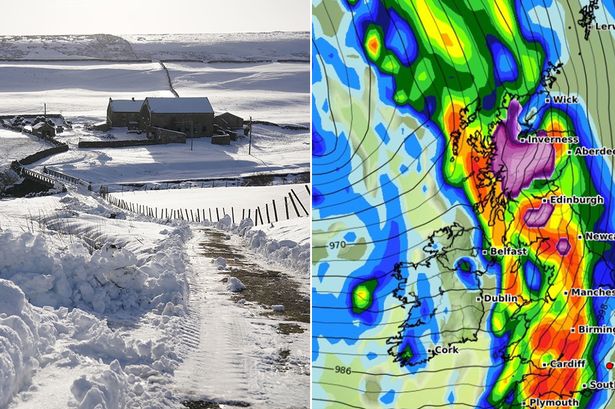The latest weather models indicate the United Kingdom is bracing for a significant winter storm towards the end of the month, potentially impacting a vast area spanning approximately 1,000 kilometers. This impending weather system is predicted to bring a mixed bag of precipitation, including both snow and rain, with the Met Office acknowledging the possibility of substantial snowfall in certain regions. While the precise track and intensity of the storm are still subject to change as forecast models are refined, the early projections suggest a wide-ranging impact across the country, raising concerns about potential travel disruptions, power outages, and general winter weather hazards.
The formation of this expansive winter storm is attributed to a complex interplay of meteorological factors. A key driver is the expected development of a deep low-pressure system over the North Atlantic, fueled by contrasting air masses. Cold Arctic air plunging southwards will collide with milder, moisture-laden air originating from the Atlantic, creating the perfect conditions for intense precipitation. The exact location of this clash will determine whether predominantly rain or snow falls over specific areas of the UK. Higher elevations and regions further north are more likely to experience significant snowfall, while lower-lying southern areas may see a mix of rain and sleet. The strength and direction of the prevailing winds will also play a crucial role in shaping the storm’s path and its eventual impact on various parts of the country.
The Met Office, the UK’s national weather service, has issued preliminary warnings about the potential for disruptive winter weather later this month. While specific details regarding snowfall amounts and affected regions remain uncertain at this stage, the agency has emphasized the need for preparedness. They advise the public to stay updated on the evolving forecast and to take necessary precautions in anticipation of potential heavy snow, strong winds, and icy conditions. This includes ensuring adequate home heating, stocking up on essential supplies, and planning for potential travel delays or cancellations. The Met Office also collaborates closely with local authorities and emergency services to coordinate responses and ensure public safety in the event of severe weather.
The prospect of a large-scale winter storm raises several concerns for various sectors across the UK. Transportation networks, including roads, railways, and airports, are particularly vulnerable to disruptions caused by heavy snow and ice. Road closures, flight cancellations, and train delays are possible, potentially impacting commuters, businesses, and supply chains. Power outages are another significant risk, as heavy snow accumulation can weigh down power lines and disrupt electricity distribution. This can lead to heating disruptions in homes and businesses, impacting vulnerable populations and essential services. Furthermore, agricultural activities may be affected by snow cover and freezing temperatures, impacting livestock and crop production.
Preparing for a significant winter storm requires a multi-faceted approach involving individuals, communities, and authorities. At the individual level, ensuring an emergency kit with essential supplies like food, water, medications, and flashlights is crucial. Checking home heating systems and insulation can help maintain comfortable temperatures during potential power outages. Staying informed about weather updates and travel advisories is essential for making informed decisions about travel plans and outdoor activities. At the community level, coordinating neighborhood support networks, especially for vulnerable individuals, can help ensure everyone’s well-being during adverse weather conditions. Local authorities play a vital role in preparing for winter storms, coordinating snow removal operations, ensuring road safety, and providing support to affected communities.
The predicted winter storm serves as a reminder of the challenges posed by extreme weather events and the importance of proactive preparedness. While the precise impact remains to be seen, the current projections emphasize the need for individuals, communities, and authorities to take appropriate measures to mitigate potential risks. By staying informed, taking proactive steps, and working collaboratively, the UK can minimize disruptions and ensure the safety and well-being of its citizens during this potential period of adverse winter weather. Continuous monitoring of the evolving weather patterns and refining the forecast models will provide more accurate predictions in the coming days, allowing for better-targeted preparations and responses. The potential economic and social impacts of the storm underscore the importance of resilient infrastructure and effective emergency response mechanisms to cope with the challenges of increasingly frequent and intense weather events.














